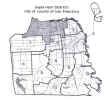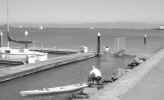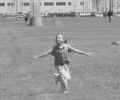District 2: reality checks
 It’s Travelogue Central. With clear
Mediterranean skies, tree-lined streets, and pastel stucco
houses, Seacliff/Presidio Heights, Laurel Heights/USF,
Pacific Heights, Cow Hollow, the Marina, and Russian Hill
provide the prototype for Baghdad by the Bay. Surely, these
six neighborhoods have contributed more than their fair
share to the world’s image of San Francisco.
It’s Travelogue Central. With clear
Mediterranean skies, tree-lined streets, and pastel stucco
houses, Seacliff/Presidio Heights, Laurel Heights/USF,
Pacific Heights, Cow Hollow, the Marina, and Russian Hill
provide the prototype for Baghdad by the Bay. Surely, these
six neighborhoods have contributed more than their fair
share to the world’s image of San Francisco.
Back in the 1940s, when California was
still a faraway unapproachable place to most Americans,
radio audiences eagerly followed the domestic doings of
"One Man’s Family" in Seacliff, where a foghorn
often sang counterpoint to the dialogue. Countless
moviegoers came to see Pacific Heights as a site of the good
life: one of the accoutrements that goes with the Japanese
consul-general’s elegant house on Vallejo is a collection
of the films made on its premises, including "Guess Who’s
Coming to Dinner." And no guidebook to the area is
complete without a photograph of the Marina and the Golden
Gate Bridge. "In the residential district of Pacific
Heights and the Marina," says James Benét’s 1966
Guide to San Francisco and the Bay Region, "three
generations of San Francisco’s business, political, and
social leaders have built fascinating revelations of their
taste and character. Here, especially on the Heights, are
the mansions of the city."
Closer to home, the area has acquired
other resonances. In a city riven by economic disparity, it
has become a symbol of reactionary respectability. "You
don’t see them trying to put homeless shelters in Pacific
Heights," Tenderloin residents grumble.
Anti-development groups echo their plaint: "Imagine the
uproar if they tried to tear down some of those old houses
on Jackson and build condos in their place." If SoMa is
dot.com heaven, the north side of town is where the
preceding wave of well-heeled settlers put down roots.
Advises San Francisco Underground Travel, "Pacific
Heights is where all the yuppies in San Francisco live….
You can easily combine this with a trip towards the bay [to]
the true yuppie kingdom, Marina Green and Chestnut
Street."
Ever since the cablecar arrived on the
scene in 1878 to carry newly rich residents to greater
heights, the folks who live on the hill — whether Russian,
Pacific, or Presidio — have invited invidious comparisons.
And in the present-day political world, they certainly are a
different lot, as the data gathered by researcher David
Binder make clear. In a city known for its diversity, 78
percent of all District 2 residents are white. They’re
highly educated: among the district’s likely voters, 76
percent are college graduates, compared to 61 percent
citywide. They are indeed more affluent: 51 percent earn
over $50,000 a year, in contrast to 40 percent throughout
the city. But what may set them most distinctly apart is
their party affiliation. To Democratic and further-left San
Francisco, Republicans seem to be everywhere — they
constitute 31 percent of all likely voters, compared to a
piddling 17 percent for the city as a whole.
There’s a political truism that
characterizes San Francisco politics, or at least it has in
the past. When the city goes progressive, the votes come
from the eastern districts, including the eastern reaches of
Russian Hill. When conservatives rule, their support traces
a giant "C" that rings three sides of the urban
peninsula. Holding up the roof of the "C" is the
wide east-west expanse of District 2. Binder notes that the
voters in this district are
• somewhat more likely to support
tough-on-crime measures and measures restricting homeless
behavior;
• somewhat less likely to support
environmental measures and pro-tenant measures;
• much less likely to support
pro-labor, pro-diversity, and progressive taxation
measures.
Makes sense, doesn’t it?
 But
even in this district, the stereotypes only take us so far.
It turns out that, beneath the sheared Persian lamb’s
clothing, this wolf puts on his pants one leg at a time,
just like everyone else in the city. If you find the mixture
of this metaphor daunting, you might consider that, no
matter what kind of profile the statistics trace, the
residents of District 2 still live in San Francisco and are
still subject to the same winds of change that buffet the
rest of us. It may just turn out that, with the advent of
district elections, the necessity of new alliances will
redefine their familiar features.
But
even in this district, the stereotypes only take us so far.
It turns out that, beneath the sheared Persian lamb’s
clothing, this wolf puts on his pants one leg at a time,
just like everyone else in the city. If you find the mixture
of this metaphor daunting, you might consider that, no
matter what kind of profile the statistics trace, the
residents of District 2 still live in San Francisco and are
still subject to the same winds of change that buffet the
rest of us. It may just turn out that, with the advent of
district elections, the necessity of new alliances will
redefine their familiar features.
For starters, consider that, despite the
popularly painted picture of property-owners hunkered down
in multimillion-dollar mansions, most residents of District
2 are renters — 74 percent, compared to 65 percent
citywide. Rent hikes tend to defy gravity and trickle up. As
pressures on the housing market increase, even affluent
renters are likely to sense a strain on their bank accounts.
A Cow Hollow chapter of the Tenants Union seems a little
far-fetched, but beleaguered pocketbooks do make strange
bedfellows.
Or consider that bugbear of modern urban
living, traffic. The 120,000 cars that cross the Golden Gate
Bridge every day cannot compete with the monster rush of
270,000 vehicles invading SoMa via the Bay Bridge.
Nevertheless, they make a mighty mess of travel along the
commercial corridor of Lombard, with — according to Joan
Girardot of the Marina Civic Improvement Association — 40
percent of the frustrated drivers seeking an alternate route
along residential Bay and Marina Boulevard. Factor in $15
million in state funding newly available for repairs to
Doyle Drive, and nearby neighbors fear an even greater
spillover into local streets. It doesn’t stop there.
Lacking evidence of coordinated planning, they foresee other
tie-ups caused by unmonitored growth in the Presidio.
A mini-tempest in the yacht harbor mimics
many of the whirlwinds stirring up dust in other parts of
San Francisco. Last spring the city controller Ed Harrington
released an audit describing the harbor as home to
"deteriorated and, in some cases, dangerous
facilities," the result of years of incompetent
management. The stretch of water in question laps the shore
of twelve-acre Marina Green, which is Rec and Park turf.
Then acting general manager Joel Robinson floated plans for
increasing berth fees, constructing breakwaters, and
possible privatizing the operation of the harbor. Supervisor
Gavin Newsom called for hearings, expressing concern over
the threat of turning the area into an exercise in private
enterprise: "From my perspective, bringing in private
management would be an acknowledgment that the city has
failed."
Residents protested the revival of a plan
to construct two new breakwaters off the spit near the Wave
Organ, a proposal that the Board of Supervisors had
emphatically squelched in 1994. Silly rich folks, media
reports implied; the Examiner quoted a Newsom staffer
statement that they didn’t want their bay views
obstructed. Don’t be naïve, snorts Joan Girardot. It
would be difficult to block the views of homes along Marina
Boulevard, where the first floor is simply garage space and
the living area begins on the second floor. The issue is the
preservation of open space. New breakwaters will fill in the
bay and obstruct views from the public promenade near the
water’s edge. They will further close off the existing
inner west harbor, adding to the stagnation and filth of the
water there. Girardot speaks of a cabal of boat owners and
the denial of public access to the audit.
The preservation of open space along the
waterfront. Opposition to filling in the bay. Distrust of
behind-the-scenes planning for development. Sound familiar?
 For
this fall’s election, District 2 took the easy way out,
nominating just one candidate for supervisor, Gavin Newsom.
But over the next few years, alliances with other
like-minded neighborhoods may open new channels for
involvement. The political structure on which the district
rests may turn out to be as unstable as the 1906 earthquake
rubble on which it was built. The next time the residents
have to choose, it will be interesting to see who has jumped
onto the boat.
For
this fall’s election, District 2 took the easy way out,
nominating just one candidate for supervisor, Gavin Newsom.
But over the next few years, alliances with other
like-minded neighborhoods may open new channels for
involvement. The political structure on which the district
rests may turn out to be as unstable as the 1906 earthquake
rubble on which it was built. The next time the residents
have to choose, it will be interesting to see who has jumped
onto the boat.